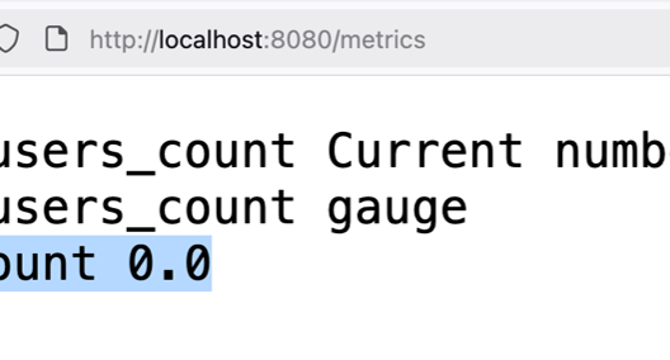Programming News
Self-Learning-Java
218

Image Credit: Self-Learning-Java
How to expose Gauge metric using Prometheus Java Client?
- Prometheus uses Gauge as a metric type to represent a single numerical value that can fluctuate.
- Gauge is used to track current values that can go up or down such as memory, CPU usage, and queue size.
- In Java with Prometheus client library, Gauges are defined and updated based on logic like setting, increasing, or decreasing values.
- An example Java application with Gauge metric for active users count is provided, demonstrating how to use Gauges to monitor and expose metrics.
Read Full Article
13 Likes
Self-Learning-Java
436

Image Credit: Self-Learning-Java
How to add labels to the exposed Prometheus metrics in Java?
- Prometheus uses labels as key-value pairs attached to metrics to provide more context.
- Labels in Prometheus help differentiate data points for a metric.
- In Java, labels can be added when building metrics using methods like 'labelNames'.
- Labels can be set and incremented for metrics to capture specific information such as endpoint and app name.
Read Full Article
26 Likes
Javacodegeeks
200

Image Credit: Javacodegeeks
Add Line Break After Log Statement Example
- Logging is crucial for understanding application behavior, but raw logs can be overwhelming without clear separation.
- Adding a line break after log statements can enhance log readability and distinguish between operations.
- Methods to add line breaks in Java logs include using System.lineSeparator() dynamically for platform-specific separators.
- By appending System.lineSeparator() to log messages, blank lines can be added effectively.
- Using SLF4J placeholders, System.lineSeparator() can be incorporated for better log formatting.
- An example code snippet demonstrates adding line breaks after log statements.
- Another approach involved pre-Java 7 usage of System.getProperty("line.separator") for line breaks.
- Configuring global blank lines in log patterns (e.g., logback.xml) can offer a consistent way to add spacing.
- Logback configuration with %n%n appends an extra blank line globally for better log layout.
- In conclusion, setting up logger patterns globally for blank lines can improve log readability, aiding in effective log analysis.
Read Full Article
11 Likes
Medium
284

Image Credit: Medium
My Node.js App Was Dying… Here’s How I Saved It
- The author shares their experience of rescuing a Node.js application that was struggling with performance issues as user traffic increased.
- Initially, the application worked well on the author's machine but started slowing down and crashing as more users accessed it.
- The author and their team developed a real-time collaboration tool that faced challenges such as requests timing out, user complaints about lag, and server logs indicating issues.
- To improve the application's performance, the author decided to delve deeper into Node.js capabilities and implement necessary changes to optimize the app.
Read Full Article
17 Likes
Discover more
- Software News
- Web Design
- Devops News
- Open Source News
- Databases
- Cloud News
- Product Management News
- Operating Systems News
- Agile Methodology News
- Computer Engineering
- Startup News
- Cryptocurrency News
- Technology News
- Blockchain News
- Data Science News
- AR News
- Apple News
- Cyber Security News
- Leadership News
- Gaming News
- Automobiles News
Insider
360

Image Credit: Insider
Tech companies have a new hiring requirement: vibe coding
- Tech companies like Visa, Reddit, DoorDash, and others are now seeking candidates with experience in vibe coding, which involves using AI tools to generate code.
- Vibe coding is being viewed as a way to boost product development speed, with companies aiming to increase their productivity by utilizing AI coding tools like Cursor and Bolt.
- While vibe coding is becoming increasingly essential for faster coding and prototype generation, it is not expected to replace senior engineers in the industry anytime soon.
- The emphasis on vibe coding in tech job ads reflects the industry's focus on accelerating product development and enhancing engineering team efficiency through AI-driven coding tools.
Read Full Article
21 Likes
Dev
191

Image Credit: Dev
AI Funding and Developments: Navigating the 2025 Landscape
- AI funding in 2025 continues to surge, with global venture capital investments surpassing $80 billion in Q1. North America leads with 86.2% of global AI capital influx.
- India emerges as a strong player in AI, with government initiatives, infrastructure enhancement, and rising startup activity propelling the nation forward.
- Notable funding highlights include OpenAI securing a $40 billion round, Anysphere raising $900 million, and Inflexor Ventures targeting a $150 million fund for AI investments.
- Investors prioritize AI ventures with proven use cases and ROI, leading to a shift towards vertical AI applications and an emphasis on ethical and governance frameworks.
Read Full Article
11 Likes
PlanetPython
195

Image Credit: PlanetPython
Django Weblog: Django bugfix releases issued: 5.2.3, 5.1.11, and 4.2.23
- Django team issues bugfix releases for Django 5.2.3, 5.1.11, and 4.2.23 to complete mitigation for CVE-2025-48432.
- The updates address potential log injection via unescaped request path by migrating remaining response logging paths to a safer implementation.
- The bugfix releases do not introduce new CVE but strengthen the original fix, urging all Django users to upgrade promptly.
- Patches to resolve the issue have been applied to Django's main, 5.2, 5.1, and 4.2 branches, with download links and checksums provided for the new releases.
Read Full Article
11 Likes
Pymnts
108

Image Credit: Pymnts
Bank of America Taps Merchant Data to Boost Payment Approval Rates
- Bank of America is leveraging merchant data to enhance payment approval rates.
- Data sharing between issuers and merchants is crucial to improve authorization decision-making, especially in the rise of card-not-present transactions.
- Technology solutions like Trusted merchant IDs and APIs are being utilized for better authentication decisions and claims investigations.
- Efforts are being made to optimize the payment experience by securely storing card information for future use and enhancing security measures like 3DS 2.0 and 3DS Data Only.
Read Full Article
6 Likes
Dev
142

Image Credit: Dev
Developers, Stop Guessing , Real Users Are Telling You What Works
- Real users behave differently from developers' test assumptions.
- Emulators do not capture real touch interactions, network fluctuations, device-specific rendering quirks, and performance impacts accurately.
- A/B testing is effective only when based on how users experience the app, accounting for real device behavior.
- Real device testing tools like NativeBridge provide deep interaction metrics and enable UI-first A/B tests on actual devices for better app optimization.
Read Full Article
8 Likes
Dev
271

Image Credit: Dev
🎯"Don’t Forget Your Git Identity: A Must-Do When Starting a New Project"
- Setting up your Git config, including your name and email, is crucial when starting a new project to avoid misattributed commits or incorrect identities.
- Configuring your Git identity ensures that commits are correctly linked to your profile and maintains a consistent commit history in team projects.
- Git config can be set using --local, --global, and --system scopes, with --local being project-specific, --global for user-wide settings, and --system for system-wide configurations.
- Best practices include using --local for project-specific identities, avoiding --system unless necessary, and always verifying Git config settings before committing to a new repository.
Read Full Article
16 Likes
Dev
360

Image Credit: Dev
When Code Feels Empty: A Developer’s Honest Confession
- A developer reflects on how coding used to give them a sense of accomplishment and intelligence, but now leaves them feeling empty.
- Despite trying new languages and projects, the spark for coding did not return, leading to a realization that purpose and meaning were missing.
- The developer discovered that coding without a sense of purpose was the underlying issue, leading them to explore new avenues like writing, AI, psychology, and creative tech.
- The advice to developers feeling stuck is to give themselves space to explore and find what truly ignites their passion, rather than forcing themselves to love coding every day.
Read Full Article
21 Likes
Nordicapis
334

Comparing 7 AI Agent-to-API Standards
- Agentic AI has gained significant popularity, with many companies implementing it and planning to expand its use in the coming year.
- New standards have emerged to allow AI agents to interact directly with APIs, offering various approaches that are not necessarily competitive but rather complementary.
- Anthropic's MCP (Model Context Protocol) aims to extend AI tools like LLMs by connecting applications and data sources to provide relevant context for tasks.
- Google's A2A (Agent2Agent) protocol enables communication between AI agents using 'Agent Cards' to describe capabilities, utilized by companies like Google and Salesforce.
- Cisco's ACP and AGP proposals under the AGNTCY initiative are designed to create an 'Internet of Agents,' allowing diverse agents to interact.
- Wildcard's agents.json provides a lightweight schema for describing agents' metadata, aiding in discovering and implementing the right agent, used by companies like Slack and HubSpot.
- LangChain's Agent Protocol offers a REST-based specification for deploying LLM-powered agents, facilitating orchestration in production environments, utilized by companies including Cisco and Fetch.AI.
- Agile Lab's Agent Specification, available as a detailed YAML file, helps standardize agents by describing their domain, value, and target user, offering a comprehensive approach for integration.
- AI agent-to-API standards play a crucial role in enabling agents to communicate effectively, ensuring secure and efficient interactions between autonomous agents.
- The variety of standards available cater to different needs, such as integrating agents into local tools, designing multi-agent ecosystems, connecting agents to APIs, or facilitating agent integration in various environments.
Read Full Article
20 Likes
Medium
195

Image Credit: Medium
ML.NET vs Python: Which One Should You Use for Machine Learning in 2025?
- ML.NET is a different approach from Python for machine learning, designed to integrate seamlessly with .NET applications.
- ML.NET allows developers to stay within the .NET ecosystem, avoiding the need to switch languages or tools.
- Python, on the other hand, is known for its conciseness, while ML.NET offers direct integration into .NET applications for easy production deployment.
- Tutorials for both ML.NET and Python are available on Archety.dev to help users learn and choose based on their preferences.
Read Full Article
11 Likes
Medium
71

The Art of Balance: Navigating SSR, SSG, and CSR in Modern Frontend Architecture
- Client-Side Rendering (CSR), Server-Side Rendering (SSR), Static Site Generation (SSG), and Incremental Static Regeneration (ISR) are core tools in modern frontend architecture.
- Choosing the right rendering method depends on factors like content volatility, SEO importance, performance, server load, interactivity, and user experience.
- Most large-scale applications use a hybrid approach incorporating frameworks like Next.js, Nuxt.js, and SvelteKit for flexible rendering strategies.
- Dynamic routing and caching strategies play crucial roles in optimizing performance and scalability in modern frontend development.
Read Full Article
4 Likes
Dev
365

Image Credit: Dev
Read This Before OOP-ing Your Project : The Curse of Inheritance.
- The writer shares their experience of how Object-Oriented Programming (OOP) almost derailed their project despite loving OOP initially.
- The complexity arose when working on a UI framework in C++, where issues with polymorphism and inheritance in strongly typed OOP languages became apparent.
- Polymorphism in OOP allows different classes to inherit from the same parent but can lead to limitations in accessing specific behaviors of subclasses.
- Solutions proposed include bloating the base class with all possible behaviors, premonition design anticipating future behaviors, and downcasting for runtime identification.
- However, these solutions introduce complexities and make maintenance challenging, leading to a refactoring nightmare.
- The writer suggests considering alternatives like Entity-Component-System (ECS), Procedural programming with 'Dead Objects,' and using Unions or Algebraic Types over OOP Inheritance for future projects.
- They highlight the pitfalls of OOP in practice, especially in languages like C++, urging caution before fully embracing OOP for large projects.
Read Full Article
21 Likes
For uninterrupted reading, download the app